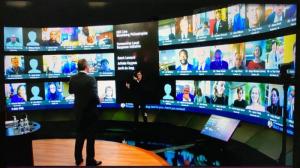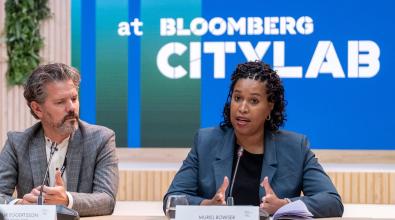7 takeaways from the first phase of the COVID-19 Local Response Initiative

For mayors and other local leaders, the COVID-19 outbreak and all the economic and social problems intertwined with it have made this the most challenging time in generations.
To bolster their leadership skills and sharpen their understanding of the health crisis, hundreds of them have taken a short break from the tumult every Thursday for the past 11 weeks to participate in coaching and learning sessions through the COVID-19 Local Response Initiative. These online events have been a unique opportunity for mayors to engage directly with the nation’s leading public health experts at Johns Hopkins University and preeminent professors in crisis leadership at Harvard’s Kennedy School of Government and the Harvard Business School.
As the first phase of these sessions wrapped up last week — and we look ahead to a second phase of sessions focused on social and economic recovery set to begin June 18 — we look back at some of the key lessons mayors have taken away so far.
[Read: Mike Bloomberg announces new COVID-19 leadership series for mayors and city leaders.]
Be ready for new outbreaks. As cities ramped up reopening efforts in May, Dr. Anthony Fauci, the nation’s top infectious disease expert, cautioned mayors to stand ready to respond quickly to new “blips of infection.” The advice reinforced what Dr. Tom Frieden, a former director of the Centers for Disease Control and Prevention had told mayors earlier: to view reopening as something like gingerly “opening a faucet” that can be shut back off if infections spike. To guide those decisions, Dr. Jennifer Nuzzo of the Johns Hopkins Bloomberg School of Public Health offered mayors some data metrics they’ll want to keep an eye on closely.
[Get the City Hall Coronavirus Daily Update. Subscribe here.]
Communicate clearly, honestly, and regularly. In a crisis like this, Harvard Professor Herman B. “Dutch” Leonard told mayors there are two things leaders must do: They need to be brutally honest about what the actual circumstances and conditions are, yet at the same time offer a rational basis for hope. Also critical is keeping up a regular communication routine — what Harvard Professor Juliette Kayyem called a “battle rhythm” — to give everyone from the public to the news media to city staff a sense of what to expect and when to expect it.
Credibility is everything, Dr. Josh Sharfstein of Johns Hopkins told mayors — “It’s really important to be honest, admit mistakes and move past them, and to be seen as a source of truth.” At the same time, authority figures aren’t the best messengers to reach every audience, Sharfstein said, so mayors need to work closely with faith leaders and other trusted community members to get out the word.
Engage the community. While mayors back in March had little choice but to shut down their cities quickly, the tough decisions ahead can and should be more deliberative. Johns Hopkins’ Dr. Caitlin Rivers told mayors in May that they should be engaging stakeholders widely around the questions of how and when to reopen businesses. Likewise, in a session on budgeting during a crisis, Harvard Professor Linda Bilmes told mayors that engaging community stakeholders is more important than ever in a time of austerity because they can help identify priorities for which programs to cut and which to protect.
Racial and ethnic disparities demand urgent attention. The disproportionate toll COVID-19 is taking in communities of color may have deep roots in historical inequality, but there are things mayors can do about it right now. Dr. Lisa Cooper of Johns Hopkins laid out five strategies, such as stepping up collection of data by race, ethnicity, and geography, and not only boosting testing capacity but making it available regardless of whether or not people have health insurance or immigration documentation. “You want to reassure folks that, if they do show up for care, they’re not going to be turned in to some authority or get hit with a huge bill,” she said.
Empower innovation. Cities have responded to the many health, economic, and social impacts of the COVID-19 crisis with a wave of new policies and programs that may constitute the most prolific period ever for municipal innovation. Harvard Professor Mitchell Weiss told mayors to keep it up — and offered a few tips for how they can turn this period of rapid experimentation into a longer term culture of city hall innovation. It’s all the things mayors and their teams have been doing during the crisis, Weiss said: Sourcing ideas widely, testing out new ideas so you can learn and adapt, and then scaling up ideas that work.
Exercise influence beyond your control. Many parts of the pandemic response lie outside a City Hall’s direct control. That doesn’t mean mayors can’t exert influence over them. That’s true of building an army of contact tracers, Dr. Sharfstein told mayors — while the direct responsibility for hiring and managing contact tracing often lies with states or counties, mayors can raise expectations and hold other leaders accountable. Likewise, when it comes to nursing homes — which are largely regulated at the state and federal level — Dr. Nuzzo told mayors there are several things they can do to stop the spread of the virus. For example, they can set up local response teams to make sure nursing homes are adhering to state and federal guidelines, and prioritize nursing homes for testing and medical supplies.
Look for transformational opportunities. As an old saying goes, a crisis is a terrible thing to waste. Previous pandemics led to the rise of indoor plumbing, sewage treatment, public parks, and other things we take for granted today. This one, too, will create a chance to build lasting change. Harvard’s Linda Bilmes noted possibilities in reorienting state and local financial investments from Wall Street to Main Street. The food delivery networks cities have set up could be leveraged in the future to combat poor access to nutritious foods in some areas, Dr. Sharfstein said. And the investment in hiring legions of contact tracers can be turned into a permanent boost in public-health capacity. “When we have a vaccine,” Sharfstein continued, “rather than just firing all the contact tracers and going back to the ways we were doing things before, mayors can use this workforce to address long-standing challenges.”
